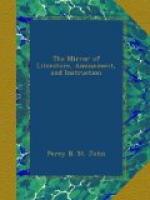THE NATURALIST.
[Illustration: Mantis, or walking leaf.]
[Illustration: Branched starfish.]
Castles, cathedrals, and churches, palaces, and parks, and architectural subjects generally, have occupied so many frontispiece pages of our recent numbers, that we have been induced to select the annexed cuts as a pleasant relief to this artificial monotony. They are Curiosities of Nature; and, in truth, more interesting than the proudest work of men’s hands. Their economy is much more surprising than the most sumptuous production of art; and the intricacy and subtlety of its processes throw into the shade all the contrivances of social man: a few inquiries into their structure and habits will therefore prove entertaining to all classes of readers.
* * * * *
1. The praying Mantis.
The Mantis is a species of cricket, and belongs to the Hemiptetera, or second order of insects. Blumenbach[1] enumerates four varieties:—1. the Gigantic, from Amboyna, a span long, yet scarce as thick as a goose-quill, and eaten by the Indians. 2. Gonglyodes, from Guinea. 3. the Religious Mantis, or Praying Cricket. 4. Another at the Cape, and considered sacred by the Hottentots. The cut represents the third of these varieties.
[1] Manual, translated by Gore.
It mostly goes on four legs, holding up two shorter ones. The hind legs are very long; the middle ones shorter. It is sometimes called the Dried and Walking Leaf, from the resemblance of its wing covering, in form and colour to a dry willow leaf; it is found in China and South America, and in the latter country many of the Indians believe that Mantes grow on trees like leaves, and that having arrived at maturity, they loosen themselves, and crawl or fly away.
Mr. T. Carpenter[2] has recently dissected the head of this species, in which he found large and sharp cutting teeth; also strong grinding ones, similar to those in the heads of locusts: the balls at the ends fit into sockets in the jaw. The whole length of the insect is nearly three inches; it is of slender shape, and in its sitting posture is observed to hold up the two fore-legs slightly bent, as if in an attitude of prayer, whence its name; for this reason vulgar superstition has held it as a sacred insect; and a popular notion has often prevailed, that a child, or a traveller having lost its way, would be safely directed, by observing the quarter to which the animal pointed, when taken into the hand.
[2] Gill’s Technological Repository, vol. iv. p. 208.




